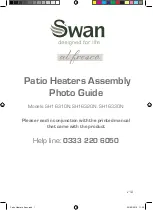
4. APPLIANCE TREATMENT
In order to provide long-term and failure-free operation of the appliance and keep its operating characteristics it is
necessary to regularly effect its examination, treatment and technical service.
In order to provide fire safety it is necessary to carefully control the burners
’ cleanness and to prevent the appear-
ance of smoky flame at gas burning, which leads to soot deposit on the heat exchanger. Herewith the spacings between
the heat exhanger
’s gills are covered with soot, in consequence of which the flame casts out of the combustion chamber,
what may lead to fire.
The examination and treatment are effectuated
by the appliance’s owner.
The appliance
’s technical service is effectuated by a specialized service organization not later than in 12 months after
the appliance’s installation and then not less than once in 12 months.
ATTENTION! Works connected with technical service are not the manufacturer company
’s warranty liabilities
an are effectuated at the customer
’s cost.
4.1.
Examination
4.1.1. Every time before switching the appliance on it is necessary to:
Make sure that there are no highly flammable objects next to the appliance;
Make sure that there is no smell of gas in the premise, in case of gas smell detection call the gas facility
emergency service.
4.1.2. After igniting the main burner it is necessary to visually check its operation: the flame must be blue, straight and
without yellow smoky edges,
indicating the burners’ sections’ inner channels dirtying.
The burner
’s sections’ inner channels dirtying causes incomplete gas combustion, which leads to following conse-
quences:
Appearance of carbonic oxide (sweetdamp) in big amounts, which may lead to poisoning;
Appearance of soot in big amounts and its deposit on the heat exchanger, which worsens heat exchange and
can lead to the appliance’s breakdown.
4.2. Treatment
4.2.1. The appliance must be kept clean, for this it is necessary to regularly remove dust from the appliance
’s upper
surface,
and also to wipe the appliance’s casing first with a moist and then with a dry wiper. In case of sustainable dirty-
ing, you should first wipe the casing with a wet wiper, moistened with a neutral detergent, and then with a dry wiper.
4.2.2. It is prohibited to use detergents of heightened effect and containing abrasive particles, gasoline and other or-
ganic solvents for cleaning the casing
’s surface and plastic details.
ATTENTION! All appliance treatment operations must be effectuated only after it is switched off and has cooled
down.










































